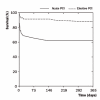Outcome and quality of life one year after percutaneous coronary interventions in octogenarians
- PMID: 18427635
- PMCID: PMC2300464
- DOI: 10.1007/BF03086129
Outcome and quality of life one year after percutaneous coronary interventions in octogenarians
Abstract
Background: While percutaneous coronary intervention (PCI) is increasingly being performed in octogenarians, little is known about the quality of life (QOL) one year after PCI. We assessed the one-year outcome and QOL after PCI.
Methods: Outcome and QOL at one year were assessed in patients of 80 years and older who underwent PCI at our institution. We used the RAND-36 Health Survey to assess health-related QOL at follow-up. The EuroSCORE was used for reference risk assessment.
Results: Ninety-eight patients (mean age 82.7+/-2.9 years; 60% female) underwent PCI. Acute PCI was performed in 36% of the patients. Canadian Cardiovascular Society (CCS) angina class before the procedure was class III for 28% and class IV for 64%. Of the patients, 98% were in the highest-risk group (additive EuroSCORE 6+). The overall PCI success rate was 94%. Mortality at one year was 19% (38% acute vs. 12% elective PCI). At followup, general health was rated as fairly good and better then before PCI (CCS I and II: 77%). RAND-36 scores for the mental component were better than scores for the physical component. Physical functioning (41+/-28) and role limitations caused by physical health problems (32+/-37) had the worst scores. The mental component vitality had the lowest (55+/-20) and mental health the highest (70+/-21) score. Social functioning was in general good (67+/-26).
Conclusion: Octogenarians have a high mortality risk following PCI, especially in acute PCI. In survivors QOL is acceptable with a better mental than physical score. In general, PCI in octogenarians has a positive effect on health perception, with less symptoms of angina pectoris. (Neth Heart J 2008;16:117-22.).
Keywords: mortality; octogenarians; percutaneous coronary interventions; quality of life.
Figures
References
-
- Centraal Bureau voor de Statistiek (CBS), database of population statistics, http://statline.cbs.nl
-
- van den Berg Jeths A, Timmermans JM, Hoeymans N, Woittiez IB. ‘Ouderen nu en in de toekomst’ Gezondheid, verpleging en verzorging 2000-2020. National Institute for Public Health and the Environment (RIVM) and Social and Cultural Planning Office of the Netherlands (SCP) by order of Ministry of Health, Welfare and Sport, Bilthoven, June 2004.
-
- Koek HL, van Dis SJ, Peters RJG, Bots ML. Hart- en vaatziekten in Nederland 2005, cijfers over ziekte en sterfte. Publication of the Netherlands Heart Foundation, April 2005
-
- Kaiser C, Kuster GM, Erne P, Amann W, Naegeli B, Osswald S, et al. and the TIME Investigators. Risks and benefits of optimised medical and revascularisation therapy in elderly patients with angina-on-treatment analysis of the TIME trial. Eur Heart J 2004;25:1036-42 - PubMed
-
- Batchelor WB, Anstrom KJ, Muhlbaier LH, Grosswald R, Weintraub WS, O’Neill WW, et al. Contemporary outcome trends in the elderly undergoing percutaneous coronary interventions: results in 7,472 octogenarians. National Cardiovascular Network Collaboration. J Am Coll Cardiol 2000;36:723-30 - PubMed
LinkOut - more resources
Full Text Sources
Miscellaneous



